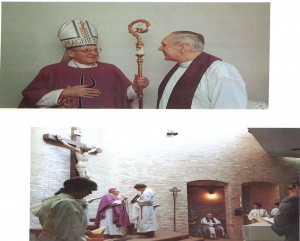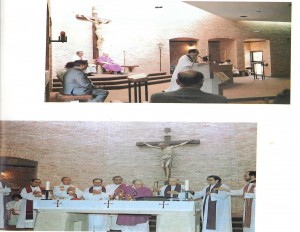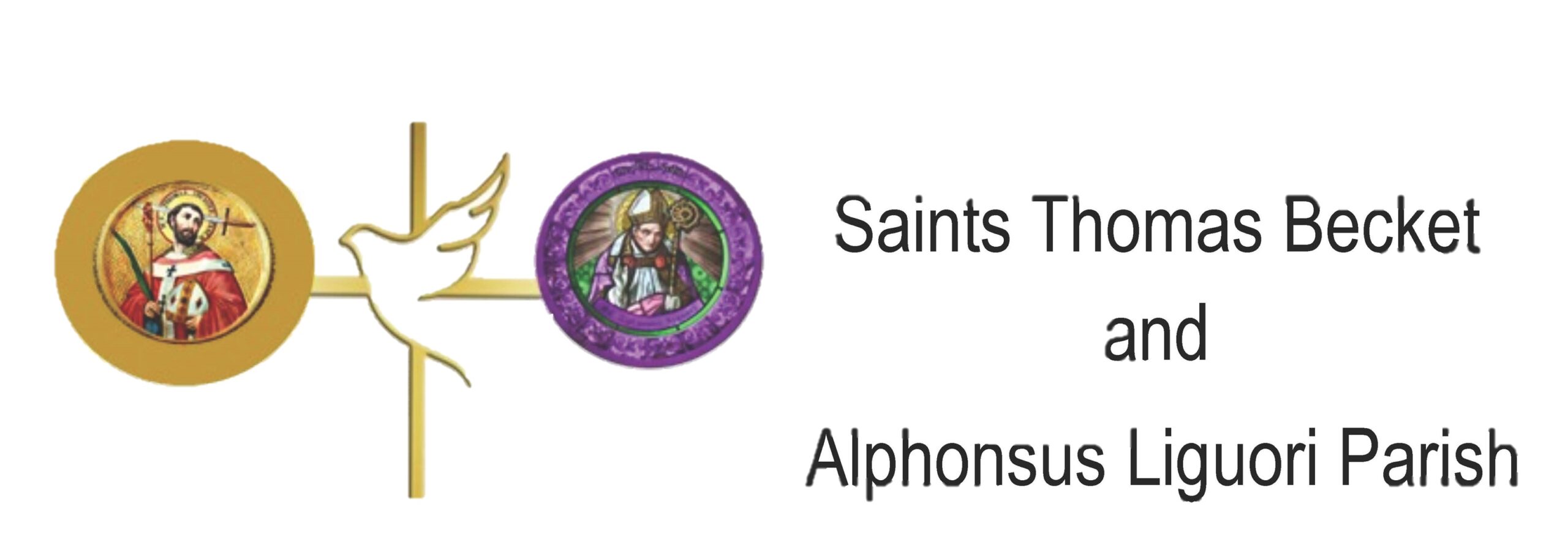Parish Mission Statement
We, the parish family of St. Thomas Becket, are a community of believers united in Christ, who dedicate ourselves to proclaim the Good News and foster a sense of belonging. As we gather together in prayer and worship, we draw our nourishment from His word and the Bread of His Table. With shared responsibility we go forth to serve and affirm our sisters and brothers. Guided by the Holy Spirit, we strive to build the Kingdom of God within and beyond our parish.
Parish Mission Statement
My, Parafia Świętego Tomasza Becketa, jesteśmy wspólnotą wiernych zjednoczonych w Chrystusie, którzy troszczymy się o Boże dziedzictwo i z oddaniem głosimy Dobrą Nowinę. We wspólnym gromadzeniu się i modlitwie, karmimy się Jego Słowem i Chlebem z Jego Stołu. Z poczuciem wspólnego obowiązku podążamy w służbie naszym braciom i siostrom. Pod przewodnictwem Ducha Świętego dążymy do budowania Królestwa Bożego wewnątrz i poza naszą parafią
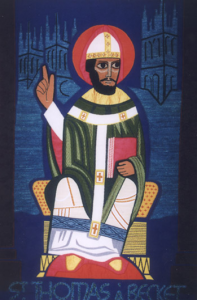 Our Patron Saint Thomas Becket
Our Patron Saint Thomas Becket
Every parish and chapel in the world is named after a patron or protector. The name chosen among three given to the cardinal for a parish founded by Father Frank Wachowski in an area of Prospect Heights was St. Thomas a Becket, the Archbishop of Cantebury (1162-1170) and a martyr for the church.Thomas of Cantebury was certainly a controversial and unusual character of the middle ages. He was a talented man who became first archdeacon of the Cathedral of Cantebury, chancellor and friend of the King of England, deacon, priest and finally bishop of Cantebury and eventually a martyr and saint.Thomas was born of a family of means in London, England on December 21, 1118. He was named Thomas because he was born on the feast day of St. Thomas the apostle. As a youth he received an excellent education as befitting his upbringing. He was educated in France, a sign that he would dedicate his life to the church though not necessarily as a priest. It was during this time that he took a vow of celibacy. As many successful young men before him, Thomas caught the eye of a powerful patron, Theobald, archbishop of Cantebury. Thomas became a member of his household, was ordained a deacon and made archdeacon of the Cathedral of Cantebury. King Stephan of England died and was succeeded to the throne by Henry II a 21 year old young man. Theobald recommended Thomas to Henry for his chancellor. Henry offered the job to Thomas. Thomas accepted and with his drive and talent, Thomas became the most important man in England save for the king. His influence over Henry was great and he became confidant and friend to the throne. At the death of Theobald it fell to the king to recommend to the chapter of Cantebury and to the Pope a new bishop. After much thought he suggested Thomas, his chancellor, who was still only a deacon. Thomas tried in vain to warn the king of the strife and trouble this could cause. The king overruled Thomas and so at age of 43 in 1162 Thomas was ordained a priest and eight days later consecrated archbishop of Cantebury. As was his custom, Thomas took his office most seriously and became the head of the church of England and its greatest defender. Unfortunately this brought him into contention with the interest of the state and of his friend Henry II. For eight years the two defended their concerns and causes and finally Thomas began to prevail. This caused much grief to Henry who in a moment of weakness exclaimed before his knights, “Is there no one in my kingdom who can rid me of this low priest”? Four of the king’s knights took the king’s wish as a command and on December 29th, 1170 eight days after his 52nd birthday, Thomas was hacked to death in a room of the cathedral. Thus Thomas ended his earthly sojourn a martyr for his faith and the defender of his flock. From that time pilgrims have come to the sight of his death and by popular acclaim declared a saint. Miracles occurred immediately. A cult to the bishop was soon begun and Pope Alexander III officially canonized the bishop of 1173. Parish History 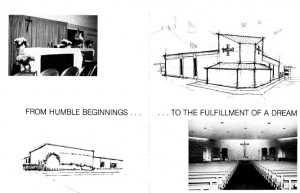 On May 15, 1968, Rev. Frank E. Wachowski was appointed by His Eminence Cardinal Cody to establish a new parish in what was then an unincorporated area of northwest Cook County known as Prospect Heights, Illinois.Father Frank, as he was to become known to his new parishioners, was given responsibility for developing the boundaries of the parish and acquiring land for the eventual construction of a church.The boundaries of the parish had to be worked out with neighboring parishes already in existence – St. Alphonsus in Prospect Heights, St. Emily in Mt. Prospect and St. Catherine Laboure in Glenview. The area decided upon is from Palatine Road on the north, Wolf Road on the west, River Road on the east, and on the south, Gregory Street, the Soo Line tracks and Foundry Road, from east to west.The task of finding an appropriate site for a church was a little more difficult. Property once owned by the Archdiocese that could have been used was claimed by the local park district for a community park and swimming pool.
On May 15, 1968, Rev. Frank E. Wachowski was appointed by His Eminence Cardinal Cody to establish a new parish in what was then an unincorporated area of northwest Cook County known as Prospect Heights, Illinois.Father Frank, as he was to become known to his new parishioners, was given responsibility for developing the boundaries of the parish and acquiring land for the eventual construction of a church.The boundaries of the parish had to be worked out with neighboring parishes already in existence – St. Alphonsus in Prospect Heights, St. Emily in Mt. Prospect and St. Catherine Laboure in Glenview. The area decided upon is from Palatine Road on the north, Wolf Road on the west, River Road on the east, and on the south, Gregory Street, the Soo Line tracks and Foundry Road, from east to west.The task of finding an appropriate site for a church was a little more difficult. Property once owned by the Archdiocese that could have been used was claimed by the local park district for a community park and swimming pool. 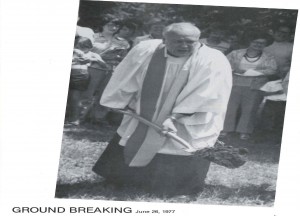 After much searching for land centrally located, available and affordable, Father Frank was able to acquire a little over five acres from a landscape nursery on Lee Street (later renamed Burning Bush when incorporated in Mt. Prospect).Finally, the parish could be organized and begin to function. The first Sunday Masses were said on September 28, 1969 in the gymnasium of Maryville Academy. During the following week, arrangements were made with the local public school district to use the school directly across the street from the parish property. From October 5, 1969, and for more than nine years thereafter, this was to be the “church” for weekend and some Holy Day Masses. Folding chairs, a portable podium and a collapsible altar were stored in the garage of a parishioner who lived next to the school. Each week, the church would be set up on Saturday afternoon and taken down on Sunday afternoon. During the first month, 247 families were registered as members of the parish. The first organization of the new parish was a CCD program of religious education for children. Classes were held in the homes of volunteer teachers, who were mostly parents, except for Sunday morning classes in the school for pre-schoolers, first and second graders. Teachers and children were enrolled and classes were begun by the end of November.
After much searching for land centrally located, available and affordable, Father Frank was able to acquire a little over five acres from a landscape nursery on Lee Street (later renamed Burning Bush when incorporated in Mt. Prospect).Finally, the parish could be organized and begin to function. The first Sunday Masses were said on September 28, 1969 in the gymnasium of Maryville Academy. During the following week, arrangements were made with the local public school district to use the school directly across the street from the parish property. From October 5, 1969, and for more than nine years thereafter, this was to be the “church” for weekend and some Holy Day Masses. Folding chairs, a portable podium and a collapsible altar were stored in the garage of a parishioner who lived next to the school. Each week, the church would be set up on Saturday afternoon and taken down on Sunday afternoon. During the first month, 247 families were registered as members of the parish. The first organization of the new parish was a CCD program of religious education for children. Classes were held in the homes of volunteer teachers, who were mostly parents, except for Sunday morning classes in the school for pre-schoolers, first and second graders. Teachers and children were enrolled and classes were begun by the end of November. 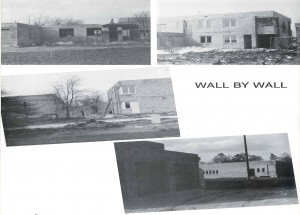 In December, Cardinal Cody approved the name of St. Thomas a Becket. While this was the second choice of the parishioners, the Cardinal felt that there were too many parishes with names similar to the first choice, Church of the Holy Spirit. Now that we were born and named, a committee was formed to have a Christening party. Arrangements were made to have a dinner dance in the hall of St. Catherine Laboure parish center on March 7, 1970. Learning that Father Frank was completing 25 years in the priesthood, the committee decided to include this occasion in the celebration. The party was a huge success with a capacity attendance, and became an annual event for the next six years. During the first two years, Father Frank resided with the priests at Maryville. In the spring of 1970, a home about six blocks north of the parish property was purchased to serve as a residence and parish center. In May, the ladies of the parish held a house-warming shower to provide cooking utensils and linens. The first CCD class to receive their First Holy Communion was at Mass on May 23, 1970 for 97 children. On August 1, 1970, an outdoor Mass was said by Father Frank on the parish property. This was followed by a family picnic in the adjacent park. During the first two years, weekday Masses were said in the home of parishioners in the evenings as often as possible. In September of 1971, the garage of the parish center was converted into a chapel. From then on, the chapel was used for daily Masses, baptisms, weddings, Holy Hours and confessions. A club for senior parishioners, later named New Horizons, was formed in October of 1971. This organization continues to provide companionship and activities for the elder members of the parish. Round Robin groups were organized in January of 1972. The purpose of these groups was to raise funds for the parish while enjoying social activities such as playing cards, sewing, crafts, etc. Very successful garage sales were handled by the Round Robin groups for several years. In May of 1972 following his ordination at St. Mary’s Seminary, Mundelein, Rev. Robert F. Tonelli was assigned to the parish as the first assistant to Father Frank. Father Bob quickly became involved in forming activities and organizations for the younger parish members. A youth group for high schoolers was formed in April of 1973. This group eventually chose the name Active Christian Teens (ACT). These teenagers have conducted car washes, paper drives and doughnut sales besides their social and religious activities. Men of the parish were invited to become charter members of a new council of the Knights of Columbus in May of 1973. The Mt. Prospect Council was eventually formed and has provided the parish with their services on many occasions, particularly at ceremonial functions. During the summer of 1973, a softball league for the girls was organized with four teams participating. The league continued for several years for the enjoyment of the young women. Plans for the new church, meeting hall and rectory were announced in November of 1975.
In December, Cardinal Cody approved the name of St. Thomas a Becket. While this was the second choice of the parishioners, the Cardinal felt that there were too many parishes with names similar to the first choice, Church of the Holy Spirit. Now that we were born and named, a committee was formed to have a Christening party. Arrangements were made to have a dinner dance in the hall of St. Catherine Laboure parish center on March 7, 1970. Learning that Father Frank was completing 25 years in the priesthood, the committee decided to include this occasion in the celebration. The party was a huge success with a capacity attendance, and became an annual event for the next six years. During the first two years, Father Frank resided with the priests at Maryville. In the spring of 1970, a home about six blocks north of the parish property was purchased to serve as a residence and parish center. In May, the ladies of the parish held a house-warming shower to provide cooking utensils and linens. The first CCD class to receive their First Holy Communion was at Mass on May 23, 1970 for 97 children. On August 1, 1970, an outdoor Mass was said by Father Frank on the parish property. This was followed by a family picnic in the adjacent park. During the first two years, weekday Masses were said in the home of parishioners in the evenings as often as possible. In September of 1971, the garage of the parish center was converted into a chapel. From then on, the chapel was used for daily Masses, baptisms, weddings, Holy Hours and confessions. A club for senior parishioners, later named New Horizons, was formed in October of 1971. This organization continues to provide companionship and activities for the elder members of the parish. Round Robin groups were organized in January of 1972. The purpose of these groups was to raise funds for the parish while enjoying social activities such as playing cards, sewing, crafts, etc. Very successful garage sales were handled by the Round Robin groups for several years. In May of 1972 following his ordination at St. Mary’s Seminary, Mundelein, Rev. Robert F. Tonelli was assigned to the parish as the first assistant to Father Frank. Father Bob quickly became involved in forming activities and organizations for the younger parish members. A youth group for high schoolers was formed in April of 1973. This group eventually chose the name Active Christian Teens (ACT). These teenagers have conducted car washes, paper drives and doughnut sales besides their social and religious activities. Men of the parish were invited to become charter members of a new council of the Knights of Columbus in May of 1973. The Mt. Prospect Council was eventually formed and has provided the parish with their services on many occasions, particularly at ceremonial functions. During the summer of 1973, a softball league for the girls was organized with four teams participating. The league continued for several years for the enjoyment of the young women. Plans for the new church, meeting hall and rectory were announced in November of 1975. 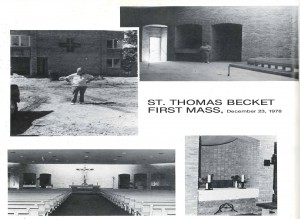 A pledge drive was inaugurated in February of 1976 and was concluded in April of that year with pledges totaling more than $434,515 payable within three years. A parish cook book was compiled and published in January of 1977, containing many favorite recipes submitted by parishioners. Father Bob was transferred to Holy Trinity Church at the Medical Center on the near south side of Chicago in May of 1977. The following month, Rev. Thomas E. Sreniawski was assigned to the parish following his ordination at St. Mary’s Seminary, Mundelein. The long-awaited day of ground breaking ceremonies was held on June 26, 1977. Later that year, the corner stone of the church was put in place on October 23, with Rev. John McEnroe, Urban Vicar, officiating.Father Tom was transferred in May of 1978 to Our Lady of the Mount parish, Cicero. Rev. James F. Ouletta was transferred to the parish as Associate Pastor in June of 1978. Father Jim was previously at St Caherine Laboure and was ordained at St. Mary’s Seminary, Mundelein in 1960.The Men’s Club was organized and held its first general meeting on November 13, 1978.While construction was not yet complete, the new church was used for Sunday Masses for the first time on December 23, 1978. The joy of Christmas was enhanced by the occasion. It wasn’t until September of 1979 that construction of the new building was completed for full use and occupancy. Meanwhile, Father Frank became seriously ill, requiring major surgery and intensive treatment. On March 9, 1980, ceremonies for dedication of the church were officiated by Cardinal Cody. Unfortunately, father Frank’s health continued to deteriorate and he was called to his eternal reward on September 1, 1980. Mass of the Resurrection was concelebrated by more than twenty priests on September 4, 1980 with the final blessing given by Cardinal Cody. Shortly before Father Frank’s death, father Jim was appointed Administrator of the parish and on November15, 1980 after a ten week mourning period a new pastor was named. Father Ralph Mollan, ordained in 1943, came to us from St. John De LaSalle parish where he had been pastor for thirteen years. With the coming of Father Mollan we now begin the second phase of our brief existence. History once again begins to flow as we build upon the foundation firmly laid by Father Frank.
A pledge drive was inaugurated in February of 1976 and was concluded in April of that year with pledges totaling more than $434,515 payable within three years. A parish cook book was compiled and published in January of 1977, containing many favorite recipes submitted by parishioners. Father Bob was transferred to Holy Trinity Church at the Medical Center on the near south side of Chicago in May of 1977. The following month, Rev. Thomas E. Sreniawski was assigned to the parish following his ordination at St. Mary’s Seminary, Mundelein. The long-awaited day of ground breaking ceremonies was held on June 26, 1977. Later that year, the corner stone of the church was put in place on October 23, with Rev. John McEnroe, Urban Vicar, officiating.Father Tom was transferred in May of 1978 to Our Lady of the Mount parish, Cicero. Rev. James F. Ouletta was transferred to the parish as Associate Pastor in June of 1978. Father Jim was previously at St Caherine Laboure and was ordained at St. Mary’s Seminary, Mundelein in 1960.The Men’s Club was organized and held its first general meeting on November 13, 1978.While construction was not yet complete, the new church was used for Sunday Masses for the first time on December 23, 1978. The joy of Christmas was enhanced by the occasion. It wasn’t until September of 1979 that construction of the new building was completed for full use and occupancy. Meanwhile, Father Frank became seriously ill, requiring major surgery and intensive treatment. On March 9, 1980, ceremonies for dedication of the church were officiated by Cardinal Cody. Unfortunately, father Frank’s health continued to deteriorate and he was called to his eternal reward on September 1, 1980. Mass of the Resurrection was concelebrated by more than twenty priests on September 4, 1980 with the final blessing given by Cardinal Cody. Shortly before Father Frank’s death, father Jim was appointed Administrator of the parish and on November15, 1980 after a ten week mourning period a new pastor was named. Father Ralph Mollan, ordained in 1943, came to us from St. John De LaSalle parish where he had been pastor for thirteen years. With the coming of Father Mollan we now begin the second phase of our brief existence. History once again begins to flow as we build upon the foundation firmly laid by Father Frank. 